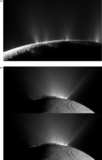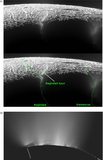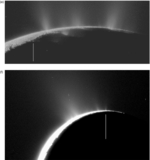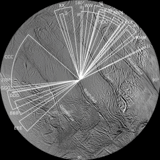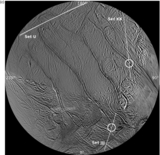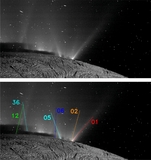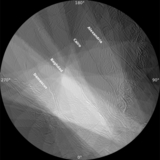Image Details

Caption: Figure 12.
Schematic illustrating current knowledge of the (a) global, (b) regional, and (c) small-scale physical and thermal structure and processes relevant to Enceladus' geysering activity, within and at the surface of the moon, inclusive of the results presented in this work. In the south polar region, the sea is ~10 km thick; the ice shell above it is ~30–40 km thick (Iess et al. 2014), comparable to the separation between the main fractures. Narrow cracks extend upwards from the sub-surface sea all the way to the surface, through both ductile and brittle layers of the ice shell. Liquid water under pressure fills the cracks, keeping them open even throughout the ductile layer and providing a conduit for vapor and sea water to reach the near-surface. Other processes, such as exsolution of volatiles, can drive vapor and water droplets all the way to the surface, forming geysers and condensing close to the surface, depositing latent heat. This heat is observed by Cassini's long-wavelength infrared instruments as the anomalous thermal radiation from the jet-active regions of the fractures. The subsurface regions immediately surrounding the sea and the cracks bearing water and vapor are expected to be warm. Regional heating from tidal flexing is also expected to be present, but is so far undetected. The ice shell beneath the SPT is likely the only place on the moon today where convection is occurring.
Copyright and Terms & Conditions
© 2014. The American Astronomical Society. All rights reserved.


